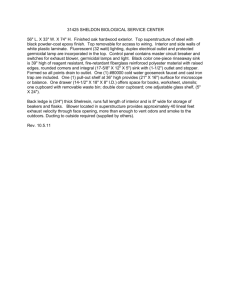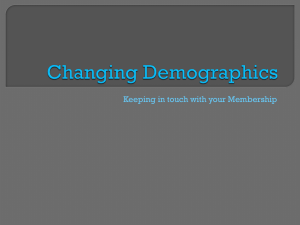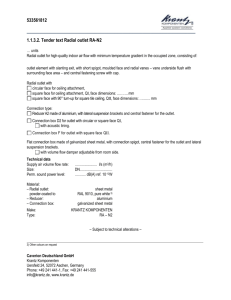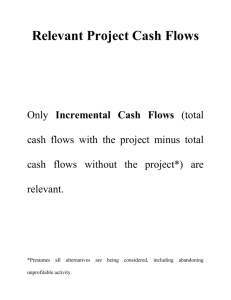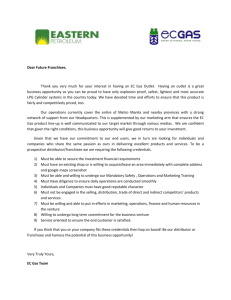Making the Case for Outlets
advertisement
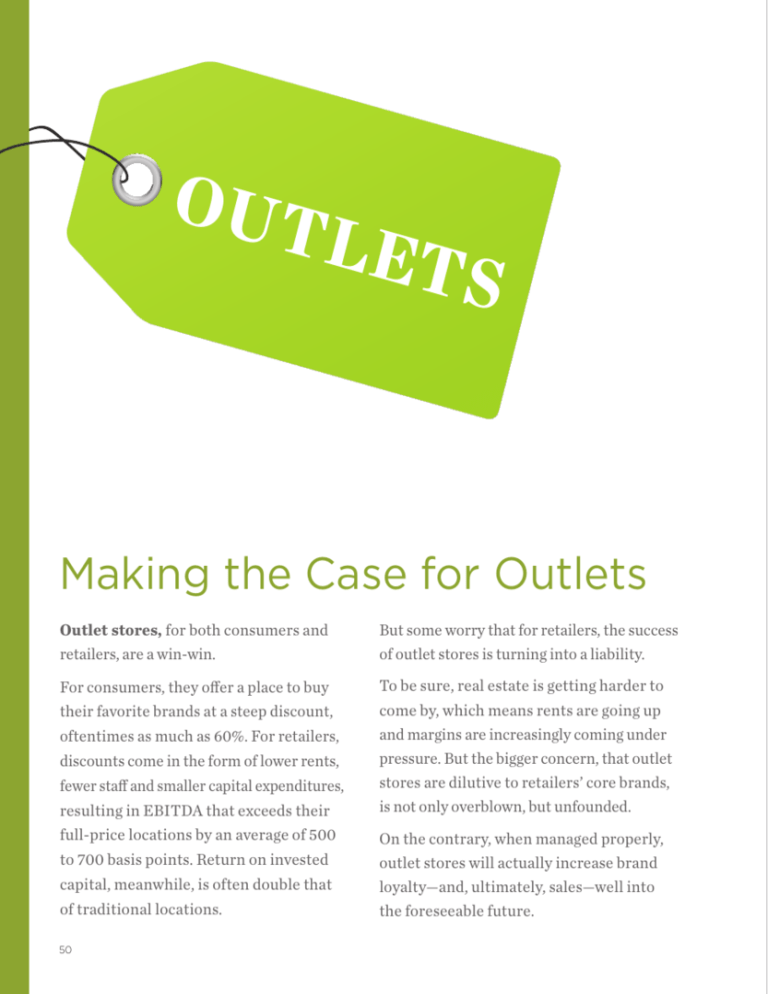
OUT LET S Making the Case for Outlets Outlet stores, for both consumers and retailers, are a win-win. For consumers, they offer a place to buy their favorite brands at a steep discount, oftentimes as much as 60%. For retailers, discounts come in the form of lower rents, fewer staff and smaller capital expenditures, resulting in EBITDA that exceeds their full-price locations by an average of 500 to 700 basis points. Return on invested capital, meanwhile, is often double that of traditional locations. 50 But some worry that for retailers, the success of outlet stores is turning into a liability. To be sure, real estate is getting harder to come by, which means rents are going up and margins are increasingly coming under pressure. But the bigger concern, that outlet stores are dilutive to retailers’ core brands, is not only overblown, but unfounded. On the contrary, when managed properly, outlet stores will actually increase brand loyalty—and, ultimately, sales—well into the foreseeable future. Outlet stores will actually increase brand loyalty—and, ultimately, sales—well into the foreseeable future. From afterthought to profit center Outlet centers were created in the 1970s as a low-cost vehicle for retailers like Nordstrom to unload their old or defective stock, the product they had trouble moving in their full-price locations, where space was needed to sell the latest inventory. The investment was easy for retailers to justify: Rents at outlet locations have historically come in some 30% to 40% below those of full-price malls, and they require fewer staff. Capex buildout is lower as well, as simpler fixtures and displays mean cheaper construction costs. Then in the early 2000s, retail giants like Ralph Lauren and Gap Inc. starting making product expressly for their outlet stores. Inspired by the current and most recent year of fashion, but with less elaborate, more cost-effective materials that yielded gross margin parity, the Made for Outlet (MFO) channel was born. The MFO channel helped to boost outlets’ ROIC even further, since with product bets based on bestsellers, the likelihood of conversion was even higher than that for last year’s leftovers. It was especially popular during the recent recession, when consumers doubled down on their hunt for lower-cost apparel and retailers tightened their inventory, resulting in fewer overstock items from their full-priced stores. The result is that outlets now generate a disproportionate share of retailers’ North American operating profits. The outlet business of Gap Inc., for example, contributes some 20% to 25% of brand sales, but accounts for 35% to 40% of its profits in the region. And even with the economy on the road to recovery, consumers have been reluctant to give up the discounts they’ve gotten used to at outlets. Total estimated sales at the 185 outlet centers in the United States came in at $25.4 billion in 2012, according to Value Retail News, up $3 billion from the year before. Sales productivity and comps rose 9% in 2012 over 2011, second only to Internet sales for most specialty fashion retailers. Further growth Retailers, many of which are shuttering or at least downsizing some of their full-price stores, are at the same time opening more outlet stores. Coach, for example, recently announced plans to close 16 of its traditional stores but open 15 new outlet locations. But newer entrants like the fast-fashion success story 51 Retailers, many of which are shuttering or at least downsizing some of their full-price stores, are at the same time opening more outlet stores. Forever 21 are also expanding their outlet store footprints, as are luxury brands like Armani, Prada and Jimmy Choo. In fact, the number of outlets is on pace to exceed the full-price locations of high-end department stores. Such is already the case at Nordstrom and Saks; Saks’ Off 5th outlets, for example, currently account for more than 60% of the retailer’s brick-and-mortar locations, and it plans to open an additional seven outlets in 2014. EXHIBIT 1: Outlet Store Growth Leading Fashion Outlets # of Outlet Stores CAGR Gap Outlet 206 5% Coach (incl. Canada) 172 13% Ralph Lauren 144 1% Banana Republic 131 20% Tanger Factory Outlet Centers, which along with Simon Property Group owns 109 of the 185 outlet centers in the United States, said that renewals resulted in a more than 23% increase in rent expense in 2012. And Simon estimates that since 2004, productivity has risen by more than 20%, but rent has gone up by nearly 50%. Guess 103 8% Ann Taylor Factory 99 2% Ann Taylor LOFT 74 52% Outlet rents are currently averaging around $38 per square foot, close to that of full-price malls. Store EBITDA margins for legacy players could be reduced by up to 500 basis points once their leases are renewed. J Crew 98 8% American Eagle 70 28% In a bid to keep up with the demand for space, real estate companies have put an additional 43 outlet center projects on the books through 2015. But along with the additional square footage comes a rise in rents. 52 Why outlets don’t mean brand dilution While the pressure on margins is real and needs to be taken into consideration going forward, the discrepancy can be more than offset by the increase in customers and resulting higher sales that come from having outlet stores, as retailers from Nike to Michael Kors to Barney’s have learned firsthand. Nordstrom’s best-performing stores, for example, are those placed closest to its Rack outlet locations. That’s because for high-end retailers, outlets open the door to an entirely new set of customers who otherwise wouldn’t shop the full-price stores, whether due to their locations in urban centers, the expensive atmosphere or the prices themselves. With an outlet store presence, luxury brands suddenly become accessible. Conversely, the number of high-end shoppers who will eschew full-price locations in favor of outlets is negligible. EXHIBIT 2: Planned Outlet Store Growth 2013–15 Current 185 Current + Planned (2013–2015) 228 70.9 Number of Centers 85.0 Square Feet (millions) 53 For mid-tier brands like Gap and J. Crew, such accessibility draws in lower-income shoppers for whom such brands were previously unaffordable. Existing customers, meanwhile, ultimately increase their number of shopping occasions due to the lower price points and wider selection that outlets provide, even while continuing to shop full-price locations. increasingly viewing the online channel as a way to capture a different, incremental customer. Outlets, in other words, will continue to grow and be a critical component in an integrated omnichannel strategy. v Making clear the difference between fullprice and outlet channels in the minds of consumers, therefore, is critical. While the brand should be consistently communicated regardless of channel, the outlet discounts have to be significant. The truly high-end, more aspirationally priced product—and the related store style elements and staff that support them—should be kept exclusively in the full-price locations. Customers’ in-store experiences, in other words, should meet their expectations. E-commerce Expanding into the online space, outlets can further accelerate growth. For example, Saks’ Off 5th launched e-commerce at the end of September. So whereas retailers previously resisted creating an online presence for their outlets for fear of price competition, they are 54 AUTHOR Michael Dart Senior Partner and Head of Private Equity and Strategy Practice michael.dart@kurtsalmon.com


